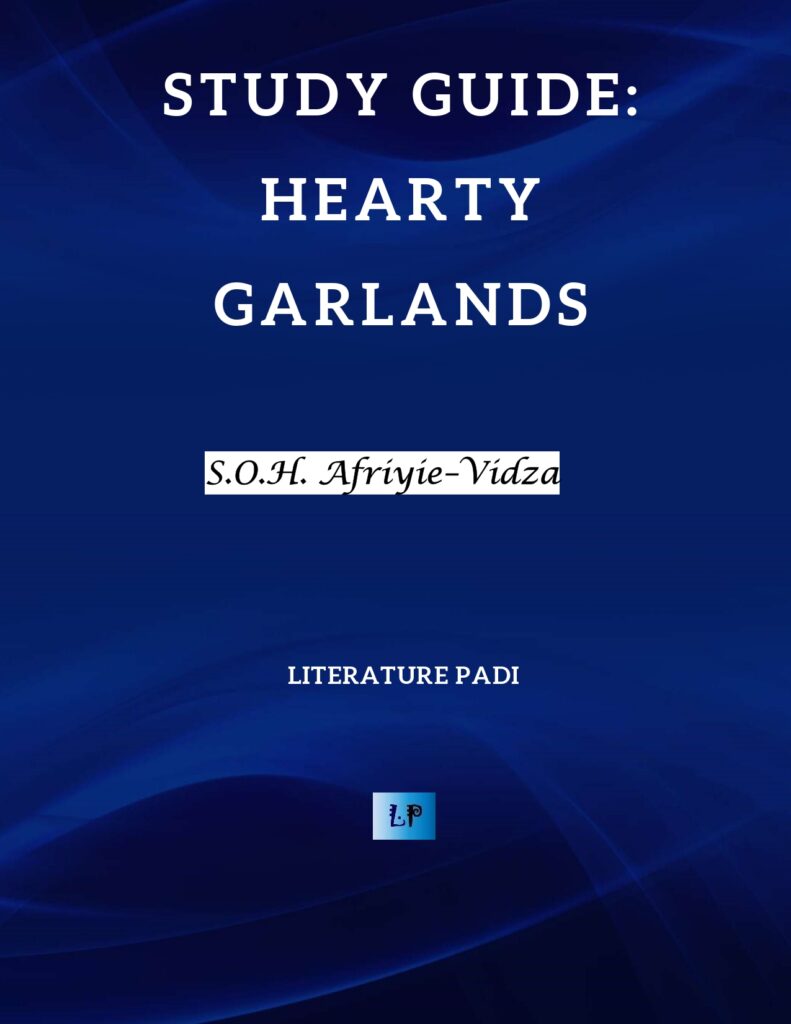🎉 Holiday Promo! Get Study Guides for 10+ WASSCE Texts — Just ₦5,000 (July 27 – Sept 18)
“Hearty Garlands” by S.O.H. Afriyie-Vidza is a thirty-five line poem that celebrates the life, accomplishments, and wisdom of an individual who has reached the age of eighty-five. The way the celebrant is celebrated in the poem is a testament to the premium value most parts of Africa and elsewhere in the world have placed on aging for centuries. Old people are revered for their age which is an evidence of their wealth of experience, wisdom, and accomplishments.
A group of younger individuals had gathered to celebrate this person who has just clocked the ripe age of eighty-five, and remind him of his accomplishments and contributions to the society. One of these individuals, the speaker, begins by acknowledging the longevity and achievements of the celebrant. He notes that despite the passage of time and the inevitable failures that come with life, the celebrant has no regrets that cripple or overshadow the beauty of his existence.
The speaker goes on to express his admiration for the celebrant, while he pays tribute to the aged person as a mentor figure who has guided others through life’s challenges. And by the end of the poem, the celebrant is urged to continue embracing life and its challenges even in the twilight of his years. He is advised to continue striving and pursuing new goals, regardless of the fact that he has lived past his best years. He is also implicitly told to live long enough in order to watch others strive and succeed.

“Hearty Garlands” is, therefore, a panegyric that praises an individual who has just reached the ripe age of eighty-five. The poem portrays the celebrant’s accomplishment and his impact on the community. While it asks the celebrant to reminisce on his long fulfilled life, it also clearly says age eighty-five is far from the end for him, which is why it states that “for yon lies mop-up work and higher tasks still/By you/To be accomplished” (l. 27-29). With old age comes a new set of roles and responsibilities in a society that is not eager to dump its old people in a nursing home.
Stanza by Stanza Analysis of “Hearty Garlands”
“Hearty Garlands” consists of thirty-five lines patterned into seven stanzas. Each stanza has five lines.

Stanza 1 (lines 1 to 5)
In the opening stanza, the speaker acknowledges the longevity and achievements of the person being celebrated. The person’s long life is seen as a journey where the entirety of existence “blooms with stark beauty” (l. 4). The addressee’s failures are depicted as experiences that do not lead to crippling regrets.
The celebrant is seen as a benchmark by which others are measured. He has lived a very long life and has achieved as much. Not many people are going to reach his ripe age or have similar impact on the people around them. So what’s a few failures beside these enviable feats for this towering figure?
Stanza 2 (lines 6 to 10)
Here, the speaker acknowledges the presence of occasional envy among those who are celebrating the person’s birthday and who must send their sincere birthday wishes to this old man who is an epitome of an age, experiences, and achievements only a few people can attain: “. . . on occasion . . ./envy fights benign Felicitation exclusively couched/For you/By us who won’t be left out of today’s joy/And must send you warm hearty birthday garlands” (l. 6-10). They are jealous of his old age and achievements because, as implied earlier, not many will have the opportunity to live to that age.
Stanza 3 (lines 11 to 15)
The speaker reveres the celebrated person as a mentor figure, someone who has guided others, including themselves, through life’s challenges: “wondrous mentor to rouges like us” (l. 11). In the process of praising the celebrant, the speaker has to downplay their behavioural conduct in a way that suggests that the celebrant has always been a beam of light that guides them to the right path especially when they are seemingly taking the wrong decisions.
The stanza also pegs the celebrant’s new age as “eight-five.” It portrays “age eighty-five” (l. 14) as a time of contentment and fulfillment. It describes this age as “life’s smiley, cloudless dawn” (l. 14) and “the gainful twilight of fulfilled dreams” (l. 15). In other words, the age paints a picture of a sense of peace, satisfaction, and accomplishment that the celebrant must have grown accustomed to in the later stages of his life.
Stanza 4 (lines 16 to 20)
There is a reconciliation between the celebrated individual’s hope and his desires in the later stages of his life, as his hope now aligns harmoniously with his past aspirations: “Hope now nods in contented concert with spent desires” (l. 16). He has no cause to regret for his action and inaction. He has done the best he could do, which is why he is not bothered by the things he could not do or become.
The celebrant is satisfied and at peace with himself. His heart, which is depicted as resting on “garlanded satis shores” (l. 19), is in tranquility. He now looks forward to good health and vitality in the future, and even more years of life on earth: “Looking out to sea for health delivering vessels” (l. 20).
Related:
- Poem: “Hearty Garlands” by S.O.H. Afriyie–Vidza
- Themes in S.O.H. Afriyie-Vidza’s “Hearty Garlands”
- 2026—2030 Recommended Literature Texts For WAEC and NECO SSCE
Stanza 5 (lines 21 to 25)
Here, the speaker urges the celebrant to watch them, from the pedestal life has placed him on, as they make efforts to celebrate him and take pride in his achievements: “Watch us strive and beat your mahogany chest in pride” (l. 24). The speaker choice of “subdued heights of your lofty conquered toils” (l. 21) and “flights of vanquished steps” (l. 22) can only mean the pedestal overcoming challenges has placed the celebrant on in the process of living a long life. Similarly, the choice of “mahogany” as a modifier of chest in line 24 seems to point to the finesse, resilience, strength and longevity of the celebrant – attributes which can as well be ascribed to any mahogany products.
The speaker equally encourages the celebrated individual to take pride in his own achievements like they are doing. The celebrant is expected to admire how long he has come and how much he has done. This is why the speaker says that the celebrant “must shake your own hands like iroko agama.” The comparison of this self-admiration and self-appreciation with iroko agama comes from the place of an African proverb that gives validation to appreciating one’s deserving efforts, regardless of whether everyone around one deem it fit or not to appreciate one for the efforts (see full explanation of this under the figure of speech section, specifically under allusion).

Stanza 6 (lines 26 to 30)
In this stanza, the speaker encourages the octogenarian to continue moving forward in pursuit of further “mop-up work and higher tasks” (l. 27). He is advised to embrace new challenges and opportunities, so he can “clinch yonder untamed gain” (l. 26).
Stanza 6 ends with the position that when the time comes, the octogenarian will hear a “trumpet sound” blown by a “guru” to cheer him for his exceptional achievements.
Premium PDF
There are 549 words left in this article and a total of 2,663 words in our premium PDF. Download the entire Hearty Garlands study guide as a printable PDF now!

Receive Literary Updates through our Social Media Channels:
- WhatsApp: Literature PADI
- Telegram: Literature PADI
- YouTube: @literaturepadi
- Facebook: Literature PADI












